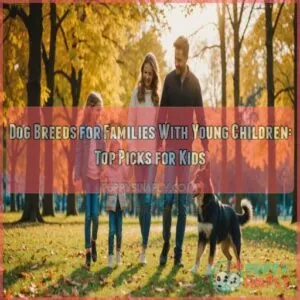This site is supported by our readers. We may earn a commission, at no cost to you, if you purchase through links.
 Looking for a furry friend that’ll bring the whole family together? You can’t go wrong with friendly family dog breeds like the Labrador Retriever, Golden Retriever, or Beagle. These pups are known for their affectionate nature, trainability, and ability to adapt to different living situations.
Looking for a furry friend that’ll bring the whole family together? You can’t go wrong with friendly family dog breeds like the Labrador Retriever, Golden Retriever, or Beagle. These pups are known for their affectionate nature, trainability, and ability to adapt to different living situations.
Whether you’ve got a bustling household or a cozy apartment, there’s a perfect pup out there waiting to steal your heart (and maybe a few treats too).
Just be sure to do your research on each breed’s unique needs and personality traits to find the one that’s the best fit. Your new four-legged companion is closer than you think!
Table Of Contents
- Key Takeaways
- Choosing the Perfect Family Dog
- Top 5 Friendly Family Dog Breeds
- Size and Energy Level Matter
- Breed-Specific Traits to Consider
- Training and Socialization Essentials
- Health Concerns and Grooming Needs
- Introducing Your New Dog to the Family
- Age and Lifestyle Considerations
- Safety and Responsibility
- Finding the Perfect Dog for Your Family
- Frequently Asked Questions (FAQs)
- What is the most friendly dog for a family?
- What is the best dog for all around family?
- What is the safest dog breed for children?
- What is the number one family dog?
- How does a dogs diet affect behavior?
- What are common signs of separation anxiety?
- Which dog breeds are hypoallergenic?
- How often should family dogs visit the vet?
- What activities are best for bonding with dogs?
- Conclusion
Key Takeaways
- Finding the perfect furry friend is a breeze when you focus on friendly family dog breeds, such as Labradors, Golden Retrievers, and Beagles. These pups are known for their affectionate nature, trainability, and ability to adapt to different living situations.
- Before you leap into dog ownership, consider your lifestyle – from your living space and activity level to your family’s needs and preferences. This will help you find the best four-legged companion that fits your family like a glove.
- Training and socialization are key to raising a well-behaved pup. Use positive reinforcement and introduce your furry friend to new sights and sounds gradually to build their confidence. With your loving guidance, they’ll be the talk of the dog park in no time.
- Bringing home a new dog is exciting, but make sure to create a safe and comfortable environment, supervise interactions with children, and establish a routine for feeding and exercise. Building a strong bond with your canine pal is the cherry on top of this furry adventure.
Choosing the Perfect Family Dog
Choosing the perfect family dog can feel like a big task, but with a little research and an understanding of your lifestyle, you’ll be on your way to finding your new furry best friend.
From energetic Labradors to cuddly Cavalier King Charles Spaniels, there’s a breed out there that’s sure to steal your heart and fit seamlessly into your family.
Factors to Consider for Your Lifestyle
Imagine this: you’ve got the perfect family dog lounging by your side.
Before you leap, consider your lifestyle.
Do you love morning jogs, or prefer couch time?
Family size, budget, and even allergies can steer you.
Picking from friendly family dog breeds means uncovering the best family dogs that fit you like a glove.
Get ready to embrace wagging tails!
Assessing Your Living Space and Activity Level
Figuring out your space and energy levels is like choosing shoes—size and fit matter!
In apartment living, smaller family dogs make wonderful companions.
Got a yard? Larger, energetic breeds will love it.
Consider family routines and energy needs: do slow weekend strolls or lively park adventures suit you?
Find friendly dog breeds that fit seamlessly into your lifestyle.
Evaluating Your Family’s Needs and Preferences
Now, with your space and activity level in mind, consider family size and schedule. Do you have time for daily walks and training? Labradors thrive in active settings, while Beagles are great with kids in bustling homes.
But if shedding isn’t your thing, maybe consider breeds that don’t shed.
Balance your budget, too—dog care can cost a pretty penny!
Researching Different Breeds and Their Characteristics
When researching different dog breeds, consider their unique characteristics. Explore a breed’s history, temperament, exercise needs, grooming requirements, and potential health concerns. This will help you find the perfect furry companion that aligns with your family’s lifestyle and preferences.
Key factors include:
- Affectionate and gentle nature
- Trainability and intelligence
- Energy level and activity needs
- Grooming demands
- Common health issues
Top 5 Friendly Family Dog Breeds
Choosing a family dog that’s friendly and great with kids can be a tough decision, but focusing on breeds known for their lovable personalities can make it easier. Learn about the dachshund’s temperament with kids.
Whether it’s the loyal Labrador Retriever or the playful Pug, these top five breeds are sure to wag their way into your heart and your home.
Labrador Retriever – Temperament and Grooming Needs
With their affable nature, Labrador Retrievers easily steal hearts.
As a family fave, they’re outgoing and keen to please.
Their exercise needs match their lively temperament—fetch anyone?
Surprisingly, grooming’s a breeze, though watch for Labrador shedding.
Here’s a quick look:
| Aspect | Details |
|---|---|
| Temperament | Affable, keen to please |
| Exercise | High-energy, daily walks |
| Grooming | Moderate, frequent brushing |
| Adaptability | Great with kids |
Golden Retriever – Intelligence and Trainability
Golden Retrievers, right? They’re the Einsteins of the dog world, known for their intelligence and willingness to please.
Like a furry family member who can actually follow directions, these pups excel in obedience, agility, and sports.
If you want your kids to experience the joys of training with one of the best dog breeds for families, a Golden Retriever won’t let you down.
Beagle – Energy Level and Affectionate Nature
Beagles are the perfect pals for playful families. Their boundless energy and affectionate nature make them a joy to be around. These clever canines thrive on attention and adore quality time with their loved ones. Get ready for endless games of fetch, cozy cuddles, and lots of tail-wagging fun!
- Energetic and enthusiastic
- Keen to please and highly trainable
- Loving and loyal companions
- Excellent with children of all ages
Cavalier King Charles Spaniel – Gentle and Adaptable
Imagine a dog that thinks it’s your shadow—that’s the Cavalier King Charles Spaniel! These gentle companions are keen to please and adapt well to your lifestyle.
With little exercise and grooming, they’re perfect for families looking for low-maintenance, loving pets.
Their warm temperament and tiny stature make them ideal for cozy spaces and hearts.
Pug – Playful and Low-Maintenance
Coming from the gentle Cavalier, you’ll find Pugs are the comedians in the canine world.
They’re playful yet low-maintenance, perfect for families with limited space.
Their charming Pug personality will keep you entertained.
Although they’re easy to groom, watch their health with regular check-ups.
Pugs appreciate short walks and simple training, making them accessible to manage and adore.
Size and Energy Level Matter
Choosing the right dog for your family means understanding that size and energy level do matter.
Whether you’ve got a cozy apartment or a sprawling yard, finding a furry friend that matches your lifestyle will keep both your home and your pup happy and harmonious.
Best Small Dogs for Families With Limited Space
If you’re tight on space, consider a small dog breed like a Pug or Cavalier King Charles Spaniel.
These pint-sized pups are content to curl up at your feet and don’t need a ton of room to run around.
Just make sure to dog-proof your home and provide plenty of indoor playtime to keep their energy levels in check.
Best Medium Dogs for Families With Average Energy Levels
If you’re looking for the best medium dogs for families with average energy levels, consider breeds like the energetic Beagle or the sweet-natured Bulldog.
They’re easy to own and adapt well to various family needs.
Medium dog training can be a breeze, with fun dog park trips and proper pet insurance.
- Happy tail wags
- Harmonious family time
- Unforgettable paw prints
Best Large Dogs for Families With High Energy Levels
Got a big yard and a busy family? Large dog breeds like the energetic Labrador Retriever or the playful Golden Retriever might fit your lifestyle like a glove!
These dog breeds for active families thrive on exercise and love joining family activities.
Just remember, training tips and regular health care keep these high-energy companions bounding happily by your side. Great Pyrenees health and grooming needs are important to remember.
Matching Your Dog’s Size to Your Lifestyle
Choosing the right dog size is like finding the perfect pair of shoes – comfort is key.
A Chihuahua might fit an apartment lifestyle, while a Labrador loves yard space.
Consider your family activity and energy level; a Great Dane may not be the best dance partner for couch potatoes.
Whatever your lifestyle, there’s a perfect family dog breed ready to call home, especially if you’re looking for a cuddly companion!
Breed-Specific Traits to Consider
If you’re looking for friendly family dogs, certain breeds stand out for their unique traits.
From the loyal and adaptable Bulldog to the high-spirited and trainable Irish Setter, each breed brings its own paw-some personality to the table.
Bulldog – Loyal and Adaptable but Low-Maintenance
Bulldogs are like the chill buddy you didn’t know you needed!
With their loyal and adaptable nature, they’re perfect for families with different living situations.
Plus, they’re low-maintenance.
Just remember, Bulldog grooming requires attention to those charming wrinkles.
Their easygoing temperament and friendly demeanor make them great.
Regular Bulldog exercise and training keep them happy and healthy—French Bulldogs have similar traits!
Irish Setter – High-Spirited and Trainable
Got a Bulldog in the mix? Consider adding an Irish Setter to your family! Known for their high-spirited antics and willingness to learn, these dogs are perfect for active families.
You’ll love their joyful energy and playful temperament, but remember, they need regular exercise and grooming.
With proper training, Irish Setters become fantastic companions for both teenagers and seniors alike.
Boxer – Energetic and Playful but Patient With Children
Switching from Irish Setters, consider Boxers. With their energetic Boxer temperament, they’re playful but surprisingly patient with children.
A Boxer requires regular exercise, adding a fun twist to family walks!
Their grooming is low-key, just like a comedian’s Sunday best.
Although not hypoallergenic, Boxers fit families on varying budgets.
Ready for love and lots of laughs!
Training and Socialization Essentials
Training your new furry friend early on is key to a well-behaved pup.
Positive reinforcement and proper socialization will help your dog become a confident, adaptable companion for the whole family.
Early Training for a Well-Behaved Dog
Training your puppy early is really important for a well-behaved dog. Start with these steps:
- Potty training tips: Patience and consistency are key—like teaching a toddler not to draw on the walls.
- Crate training success: Make it a cozy den, not a prison.
- Basic commands: Teach “sit” and “stay”—they’re as valuable as chocolate cake at a bake sale.
Socialization Techniques for a Confident Dog
Socializing your pup early is like giving them a VIP pass to the world.
Early puppy socialization helps them be confident around new faces and wagging tails.
Master dog park etiquette and introduce them gradually to various noises and sights.
For a fearful dog, take baby steps and celebrate tiny wins.
Remember, socializing with other dogs paves the way for lifelong friendships.
Positive Reinforcement Training Methods
In dog training, positive reinforcement is like the cherry on top. It’s all about using rewards to encourage good behavior.
Try these tips:
- Timing: Praise right after the act.
- Consistency: Stick to a routine.
- Treats: Who doesn’t love goodies?
- Clicker Training: A nifty tool for feedback.
- Affection: Don’t forget belly rubs!
Avoiding Common Training Mistakes
Don’t make the common mistake of being inconsistent with your pup’s training.
Stay positive and use rewards, not punishments.
Time it right – train when they’re calm, not distracted.
And remember, patience is key – your furry friend is learning, so stick with it.
They’ll get there with your loving guidance.
Health Concerns and Grooming Needs
When choosing a family dog, it’s great to be aware of health issues and grooming needs, ensuring your furry friend stays in tip-top shape.
While some breeds might enjoy a trip to the groomer more often than others, all dogs deserve love, clean fur, and a diet that doesn’t include your socks!
Common Health Issues in Family Dog Breeds
Taking care of your pup’s health can feel like walking a tightrope.
Watch for hip dysplasia and joint problems—common culprits in larger breeds.
Smaller breeds may face dental issues.
Allergies and obesity also jostle for attention.
So, keep an eye out and make sure your four-legged friend stays fit as a fiddle, happily wagging through life.
Grooming Requirements for Different Breeds
Every dog’s coat tells a fur-tale.
In the grooming saga:
- Brushing frequency: Labradors shed like nobody’s business; brush them weekly.
- Coat types: Golden Retrievers flaunt luxurious locks that need regular pampering.
- Bathing needs: Bulldogs, with their charming wrinkles, need a scrub-a-dub monthly.
Ensure you’ve got the right trimming tools and you’ll have happy, spiffy pups!
Nutrition and Diet for a Healthy Dog
Fueling your furry friend’s health starts with their diet.
From high-quality kibble to homemade meals, your dog’s nutritional needs vary by breed, age, and activity level.
Keep an eye on portion sizes, and consider supplements for extra support.
Healthy treats in moderation can be a fun way to bond too!
| Dog Food Brands | Homemade Dog Food | Nutritional Supplements |
|---|---|---|
| Purina | Chicken & Rice | Omega-3 Fish Oil |
| Hill’s Science | Ground Turkey | Glucosamine |
| Royal Canin | Sweet Potato Stew | Probiotics |
| Iams | Beef & Veggies | Multivitamin |
| Eukanuba | Salmon & Brown Rice | Antioxidants |
Regular Veterinary Check-Ups and Preventative Care
While tailoring your dog’s diet and exercise is key, don’t underestimate the power of regular veterinary check-ups.
Imagine it as a spa day for your furry friend—vaccinations, parasite prevention, dental care, and senior health evaluations all keep them in tip-top shape.
Embrace these moments and you’ll make sure they’re bounding around happily, just like a canine superhero!
Introducing Your New Dog to the Family
Bringing a dog home is exciting, but it’s essential to create a space where they feel like part of the family, not just a guest.
Make sure the kids know the dog’s not a toy, and train both sides to respect each other’s boundaries, or you might find shoes swapped for chew toys faster than you can say "fetch!
Creating a Safe and Comfortable Environment
Bringing home a new dog is like adding another scoop of joy to your family!
Start with a safety checklist for dog-proofing your environment—think pet-friendly decor and safe spaces.
Training essentials help establish routines.
Set up cozy, designated areas for them to retreat.
With these steps, your furry friend will feel snug as a bug in a rug!
Supervising Interactions With Children
Supervising interactions between your new pup and little ones is a must.
Always keep a watchful eye to make sure everyone’s safety.
Teach your kids to approach the dog calmly, avoid pulling tails or ears, and never disturb the dog while eating or sleeping.
With patience and guidance, your family will soon be the best of friends.
Establishing a Routine for Feeding and Exercise
Establishing a routine feels like setting the clock’s heartbeat.
Feed your dog twice a day, keeping meals consistent with exact portioning. A dog’s stomach is a loyal friend but doesn’t understand when time’s out the window!
Exercise is their therapy session, giving them 30 minutes to an hour daily. Mix training rewards into play; it’s a win-win!
Building a Strong Bond With Your Dog
Building a strong bond with your dog might feel like starting a new friendship.
Trust building starts with simple acts of love.
Engage in playtime fun, because who doesn’t love a game of fetch?
Incorporate dog training into family routines to strengthen your bond.
Use canine communication—eye contact and gentle words go a long way.
You’re on the right path to companionship!
Age and Lifestyle Considerations
Choosing a dog that’s just right for your family means considering your lifestyle, but also your children’s ages and energy levels.
While young kids might love a playful Beagle, older teens could appreciate the loyalty of a calm Bulldog.
What Age Should Your Kids Be for a Dog?
When should your kids be ready for a furry friend? The ideal age range is typically between 5-10 years old.
At this stage, children are old enough to understand how to interact safely with a dog, yet young enough to fully enjoy the companionship.
Just be sure to supervise playtime and teach responsible pet care from the start.
Considerations for Families With Older Children
When your kids are older, they’re ready for more responsibility and shared care of a new dog.
This maturity means less "puppy-proofing" and more family time enjoying walks or couch cuddles.
Encourage your teens to embrace independence by taking the lead on puppy training, transforming pet care into a delightful metaphor for learning life lessons.
Time flies with wagging tails!
Safety and Responsibility
Owning a family dog is a big responsibility, and teaching the kids to interact safely with your furry friend is key to keeping everyone happy and bite-free.
Teaching Children How to Interact With Dogs Safely
As your family considers a new canine companion, remember teaching kids how to safely interact with dogs is no dog’s breakfast.
Show them dog body language—tail wagging, ear positioning—and encourage gentle petting.
Make it a game to practice safe playtime.
Children should understand dogs need space, and sometimes gentle words work best.
Responsible pet ownership brings joy to everyone.
Preventing Dog Bites and Attacks
Preventing dog bites starts with understanding your pup’s body language.
Stay alert for signs of stress or fear, and never force interactions.
Muzzle training can help anxious dogs feel secure.
Early socialization is key – introduce your canine pal to new sights, sounds, and people in a positive way.
Being a responsible owner means putting safety first.
Ensuring Your Dog’s Safety and Well-being
Your dog’s safety is as important as preventing bites. Just like you’d baby-proof your home, dog-proof it!
Leash training is your best friend for walks, ensuring no unexpected adventures.
Regular vet care keeps your buddy in tip-top shape.
And hey, think about pet insurance—it’s like an umbrella for unexpected storms.
A safe pup is a happy pup!
Liability and Responsibility as a Dog Owner
Now that your dog’s safe and sound, let’s talk about the nitty-gritty of being a dog owner. You’re the maestro, responsible for dog bite prevention and keeping a leash on your furry friend.
Follow leash laws, scoop that poop, and check your insurance coverage.
Be a beacon of responsible breeding.
Finding the Perfect Dog for Your Family
Finding the perfect furry addition to your family starts with a visit to local shelters or rescue events, where you’re bound to meet dogs with diverse personalities just waiting to find their forever homes.
Take your time, ask lots of questions, and trust your instincts to make an informed decision that’ll have your kids tail-waggingly happy.
Visiting Local Shelters and Rescues
Visiting your local shelter or rescue is a fantastic way to find your new furry family member. You’ll meet pups with diverse personalities – from the playful pup who can’t wait to join your pack to the shy sweetheart longing for a loving home. Chat with the staff to learn each dog’s unique story and needs.
You’ll meet pups with diverse personalities – from the playful pup who can’t wait to join your pack to the shy sweetheart longing for a loving home.
- Energetic and outgoing
- Calm and cuddly
- Shy but affectionate
- Playful and adventurous
Meeting Different Dogs and Assessing Their Personalities
When meeting different dogs, you’ll want to get a feel for their temperament. Are they more couch potato or energetic toddler? Observe their body language; it’s their secret language of love or, sometimes, “back off.”
Dog behavior can help determine a dog’s personality.
| Personality Trait | Dog Behavior Example |
|---|---|
| Friendly | Wagging tail, nuzzling |
| Reserved | Sitting back, observing |
| Energetic | Bouncing, playful barks |
Making an Informed Decision for Your Family
It’s really important to find a fluffy friend who fits like a glove with your family-dog needs.
Take breed research seriously, weighing adoption vs. breeder options.
Imagine the wagging tails in future dog-child interactions—adorable, right?
Don’t forget budget planning for dog care essentials.
Get started, and soon, your perfect pup will bring endless joy and companionship.
Frequently Asked Questions (FAQs)
What is the most friendly dog for a family?
Imagine a joyful bundle of energy; Golden Retrievers fit the bill with their gentle, wagging tails and enthusiastic nature.
They’re perfect for families yearning for an affectionate furball ready for adventures and everlasting love!
What is the best dog for all around family?
You can’t go wrong with a Labrador Retriever for an all-around family dog as they are highly trainable.
They’re like the Swiss Army knife of pups: friendly, playful, and trainable, ready to embrace your family’s adventures with wagging tails.
What is the safest dog breed for children?
Wondering which dog breed is safest for your little ones?
The gentle, patient Labrador Retriever is a great choice – the ultimate family-friendly pup that’ll shower your kids with unconditional love and endless playtime.
What’s not to love?
What is the number one family dog?
Labrador Retrievers often steal the spotlight as the top family dog, with their friendly demeanor and playful spirit.
They’re like the perfect sidekick—always ready for fun and adventure, yet gentle enough for all ages.
How does a dogs diet affect behavior?
A balanced diet in dogs acts as a superhero cape, boosting mood and stability.
Nutrients like Omega-3s reduce anxiety, while tryptophan promotes calmness.
It’s fascinating how the right kibble can transform chaos into serenity (Source).
What are common signs of separation anxiety?
Spotting separation anxiety in dogs is like finding a storm brewing: they’ll cling like velcro, bark like mad, and leave little "surprises" around the house.
Imagine a furry Houdini, determined to escape and find you! (Source).
Which dog breeds are hypoallergenic?
If you’re an allergy sufferer, don’t worry – there are plenty of hypoallergenic dog breeds that can be your furry friend.
Look for poodles, schnauzers, and Portuguese water dogs – they shed less and produce fewer allergens.
How often should family dogs visit the vet?
You should take your family dog to the vet at least annually for checkups and vaccinations.
Save yourself a headache by catching potential health issues early, because a stitch in time saves nine in terms of pet care.
What activities are best for bonding with dogs?
Nothing beats a brisk walk with your dog, it’s the ultimate sniffari adventure!
Engage in fun play sessions, teach new tricks, or cozy up for a movie—your bond will grow stronger than ever!
Enjoy every wag and cuddle.
Conclusion
Imagine this: 69% of American households own a pet, proving just how cherished our furry companions are.
If you’re ready to join those ranks and bring joy to your family, choosing among friendly family dog breeds is a great start.
By understanding these breeds and aligning their characteristics with your lifestyle, you can find the perfect fit.
So whether it’s a Golden Retriever’s loyalty or a Pug’s playfulness, your ideal four-legged friend is waiting to be adored.
















